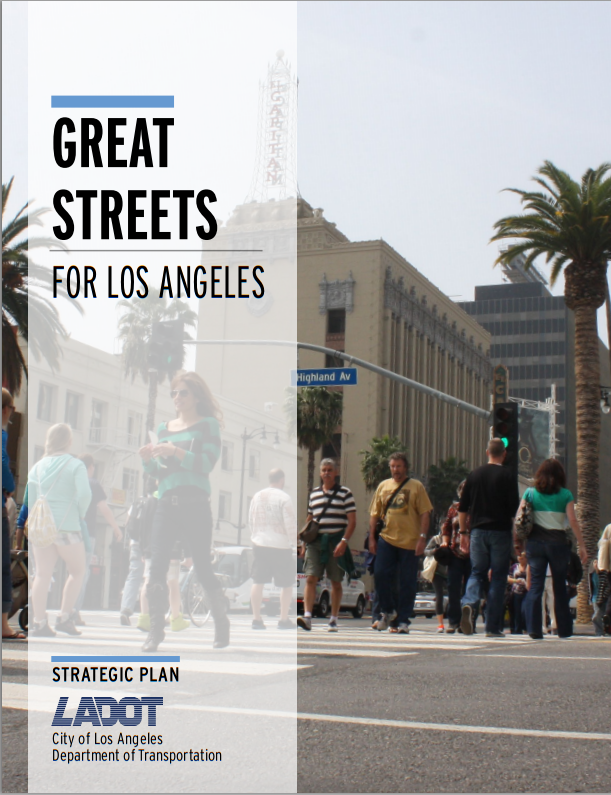
Today, the Los Angeles Department of Transportation (LADOT) released its new strategic plan, entitled Great Streets for Los Angeles.
First, we’ll editorialize enthusiastically: this plan is excellent.
And very much needed in Los Angeles.
LADOT General Manager Seleta Reynolds characterizes it as a "plan [that] requires us to do our jobs in a fundamentally different way."
There have long been holistic thinkers at LADOT, but they’ve been in the minority, squeezing in opportunistic improvements in the midst of a departmental culture that prioritized car convenience. In the past half-dozen years, under the leadership of previous General Manager Jaime de la Vega and Mayor Antonio Villaraigosa, LADOT has warmed up to a broader mission that balances the needs of all road users.
But today’s plan is a quantum leap forward.
Front and center in the new plan is Vision Zero.
For the uninitiated, Vision Zero is a transportation planning, law enforcement, and planning project started in Sweden in 1997. The goal is simple: eradicate traffic fatalities. Any traffic fatality is one too many. Every decision involving transportation, from how wide a road should be to how to target traffic enforcement efforts, must meet the goal of making the streets safer for all road users.

LADOT is thinking big -- the departmental plan is to "eliminate traffic fatalities in Los Angeles by 2025."
Under Vision Zero, L.A. joins San Francisco, New York City, and many other great cities around the world in the push to eliminate traffic fatalities. By embracing Vision Zero as its first and most prominent goal, LADOT is finally saying “enough is enough.” Safety will now be the first priority in transportation decisions going forward.
“There’s a reason it’s the first thing you see when you get into the meat of the plan,” says Reynolds of Vision Zero. “Changing the way we talk about [safety in transportation], and changing the way we think about it, and changing the way that we approach our everyday work to refocus around this -- that’s the thing that really is most inspiring and exciting to me."
"To see LADOT commit to ending traffic deaths in our lifetime is a dream come true," writes Deborah Murphy, the founder and president of Los Angeles Walks. "L.A. Walks is determined that the Vision Zero campaign will engage more city departments, including LAPD, public works, city planning and the Los Angeles County Department of Public Health, to ensure the successful implementation of the campaign and assure the improved safety of our streets."
While it is great to see LADOT take a lead on Vision Zero, it is doubly encouraging to see the department heeding Murphy’s advice -- the plan identifies city agencies as partners. Reynolds further states that "external partners are also implicit in our success." That means you, Streetsblog readers.
There's plenty more in the plan that Streetsblog readers will love. We can't get to all of it in this short article, but the plan includes: neighborhood traffic calming, bike share, car share, dedicated bus lanes, an improved bikeway network, transportation demand management, reducing disabled parking placard abuse, and plenty more.
The Los Angeles County Bicycle Coalition's Eric Bruins calls it "an ambitious yet achievable framework for the department over the next three years of Mayor Eric Garcetti's term" and commends "LADOT's new mission [which] prioritizes safe and accessible options for Angelenos of all ages and abilities, no matter their chosen mode of transportation."
What about folks who get around mostly by car? What is in it for them?
Reynolds cites improvements to traffic flow, upgrades to the Automated Traffic Surveillance and Control (ATSAC) system, and parking improvements that help reduce car congestion. But, ultimately, Reynolds steers the conversation back to improving safety:
The other thing that's in here for people who drive is Vision Zero. The incidents we have on our freeways and on our roads are some of the major cause for congestion. The way to really save that time for people is to design the streets so that those things don't happen to begin with.
Reynolds, a self-professed "management geek," also expressed excitement for documenting the department's mission and values, streamlining communications, and for implementing basic technological upgrades, including planned new internal systems for managing departmental assets and for tracking work orders electronically.
But not everyone is won over by a bold statement and progressive plan.
Bart Reed, the executive director of the Transit Coalition, argues, “...There is still a level of disconnect in projects, goals, and implementation...Take a look at the damage LADOT and Metro are planning to do to pedestrian linkage at the North Hollywood Orange/Red Line Station. Then read this report that indicates values that would never allow this backwards activity.”
Seleta Reynolds acknowledged the need to continue to build trust, stressing that LADOT is dedicated to "getting small things right." She stressed improving customer service, re-thinking communications, and even making parking signs more readable.
It is still early in Reynolds' tenure at LADOT, but this new strategic plan gives us cause for optimism. The future of L.A.'s streets looks great. And safe.
(Audio of our interview with Reynolds today is available here.)






